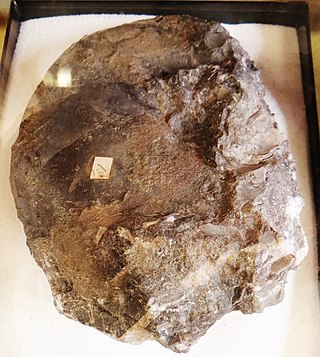Related Research Articles

The Tarphycerida were the first of the coiled cephalopods, found in marine sediments from the Lower Ordovician to the Middle Devonian. Some, such as Aphetoceras and Estonioceras, are loosely coiled and gyroconic; others, such as Campbelloceras, Tarphyceras, and Trocholites, are tightly coiled, but evolute with all whorls showing. The body chamber of tarphycerids is typically long and tubular, as much as half the length of the containing whorl in most, greater than in the Silurian Ophidioceratidae. The Tarphycerida evolved from the elongated, compressed, exogastric Bassleroceratidae, probably Bassleroceras, around the end of the Gasconadian through forms like Aphetoceras. Close coiling developed rather quickly, and both gyroconic and evolute forms are found in the early middle Canadian.
Gonioceras is an extinct genus of actinocerid nautiloidean cephalopods typified by a broad, low shell; flattened ventrally, convexly rounded dorsally; top and bottom meeting at an acute angle along the sides. In most the shell is rather thin, especially along the lateral portion. The aperture is contracted. Sutures from broad ventral and dorsal lobes, more narrowly rounded ventro-lateral and dorso-lateral saddles, and sharp pointed lateral lobes; more complex than in later Lambeoceras. The siphuncle is typically subcentral but may be closer to the venter; armenocerid in form with short segments and very short brims and containing a straight endosiphuncular canal system.
Brevicoceras is an extinct nautiloid genus from the order Oncocerida with wide distribution in the Middle Devonian in Eastern North America, Russia and Morocco. Nautiloids form a broad group of shelled cephalopods that were once diverse and numerous but are now represented by only a handful of species in two genera.
Tithonoceras is a genus of nautiloid cephalopod from the Upper Jurassic found in the Crimea, belonging to the nautilacean family Paracenoceratidae.
Tylonautilus is an extinct genus in the nautiloid order Nautilida from the Lower Carboniferous of Europe and Permian of Japan.

The Trigonoceratoidea are a superfamily within the Nautilida that ranged from the Devonian to the Triassic, thought to have contained the source for the Nautilaceae in which Nautilus is found.

Grypoceratidae is the longest-lived family of the Trigonoceratoidea, or of the near equivalent Centroceratina; members of the Nautilida from the Upper Paleozoic and Triassic.
The Centroceratidae is the ancestral family of the Trigonoceratoidea and of the equivalent Centroceratina; extinct shelled cephalopods belonging to the order Nautilida
The Naedyceras group comprises three similar and closely related openly coiled, gyroconic, genera within oncocerid family, Brevicoceratidae: Naedyceras, Gonionaedyceras, and Gyronaedyceras.
Laureloceras is a genus of the tarphycerid family Plectoceratidae that lived during the Middle Silurian in what is now North America.

The Barrandeoceratidae is a family of coiled nautiloids included in the Tarphycerida that lived from the Middle Ordovician to the Middle Devonian, characterised by mostly compressed shells with a subcentral siphuncle composed of thin-walled segments that may become secondarily ventral.(Flower and Kummel 1950, Sweet 1964).
The genus Savageoceras is a barrandeoceratid first known from the Middle Silurian of Illinois consisting of rapidly enlarging, depressed cyrtocones with a trapezoidal section; ventral side wider and flatter than dorsal; sides converging on dorsum. Sutures have slight lateral and ventral lobes and ventrolateral saddles. The surface is covered by transverse striae and has rib-like rings that are more prominent at the ventrolateral shoulders but otherwise vaguely defined. The siphuncle is central; interior unknown.
The Rhiphaeoceratidae are a small family of nautilids included in the superfamily Tainoceratoidea that comprises four very similar genera. These genera are characterized by a perforate umbilicus and little more than a single evolute coil. Whorl sections are oval, subquadrate, or subtrapezoidal. Sutures bend forward on the outer rim, forming wide shallow ventral saddles and dip strongly to the rear on the inner rim, forming deep dorsal lobes.
The Barrandeocerina comprise a suborder of Early Paleozoic nautiloid cephalopods, primitively coiled but later forms may be cyrtoconic, gyroconic, torticonic, and even breviconic, all having empty siphuncles with thin connecting rings. The Barrandeocerina were originally defined as a separate order by Rousseau Flower, but since then have been united within the Tarphycerida as a suborder. Derivation is from the Tarphyceratidae.
The Plectoceratidae is a family of tarphycerids in the suborder Barrandeocerina established as a place for the genus Plectoceras; defined simply as coiled, costate barrandeocerids with subcentral adult siphuncle.
Chidleyenoceras is a Middle Ordovician tarphyceroid with a closely coiled, evolute shell; whorl section subquadrate, widest just above a broadly rounded venter; dorsum with a broad shallow impression; sutures moderately spaced, weakly sinuous; siphuncle large, subventral, apparently orthochoantitic with tubular segments.

Barrandeoceras is a large, coiled, Middle Ordovician nautiloid cephalopod and part of the Tarphycerida. The shell is serpenticonic with whorls touching but not embracing. The adult body chamber becomes freed of the preceding whorl, a rather common character among tarphycerids. Whorl section is oval, somewhat more narrowly rounded ventrally, on the outer rim, than dorsally, on the inner rim. Prominent lateral ribs, at least on inner whorls. Grow lines show a distinct hyponomic sinus. Sutures have lateral lobes. The siphuncle is subcentral.
Plectoceras is a genus of nautiloids included in the tarphycerid suborder Barrandeocerina that lived during the Middle and Late Ordovician. It has been found widespread in the Middle and Upper Ordovician of North America.

Domatoceras is a nautiloid genus and member of the Grypoceratidae from the Pennsylvanian and Permian with a wide spread distribution.
Charactoceras is a tarphycerid genus cephalopod which lived during the Late Ordovician.
References
- Rousseau H. Flower, 1984. Bodeiceras; a New Mohawkian Oxycone, with Revision of the Older Barrandeocerida and Discussion of the Status of the Order. Journal of Paleontology v. 58, no.6, pp 1372–1379, Nov. 1984.
- Walter C Sweet, 1964. Nautiloidea-Barrandeocerida; Treatise on Invertebrate Paleontology Part K Mollusca 3. Geological Society of America and University of Kansas Press.